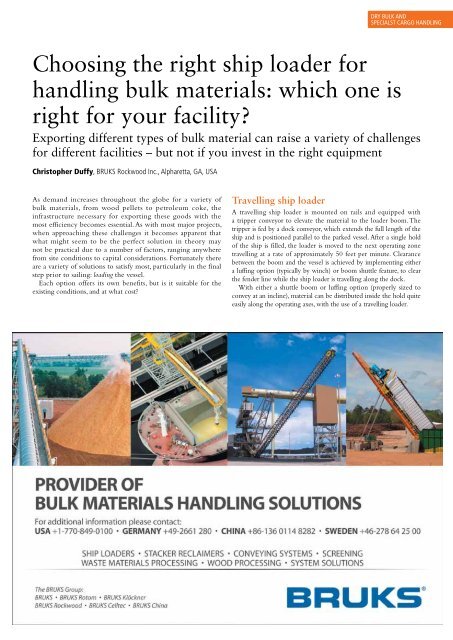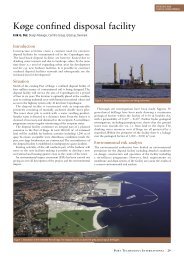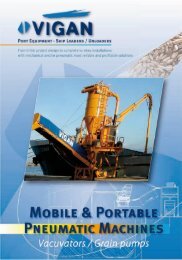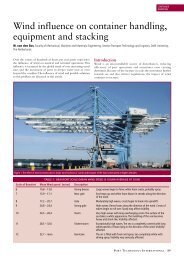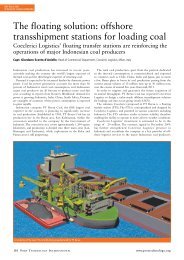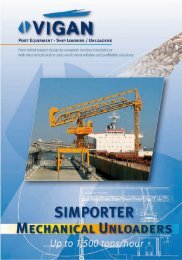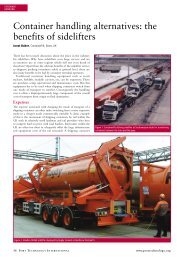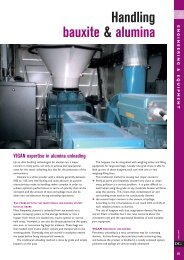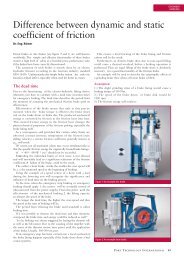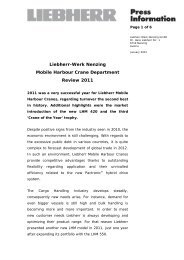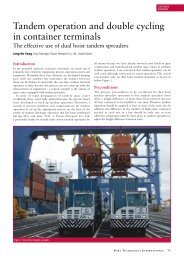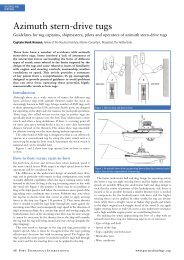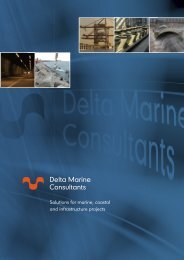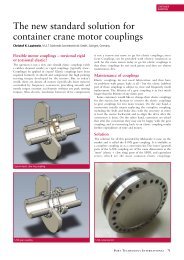Choosing the right ship loader for handling bulk materials - Port ...
Choosing the right ship loader for handling bulk materials - Port ...
Choosing the right ship loader for handling bulk materials - Port ...
Create successful ePaper yourself
Turn your PDF publications into a flip-book with our unique Google optimized e-Paper software.
DRY BULK and<br />
SPECIALST CARGO HANDLING<br />
<strong>Choosing</strong> <strong>the</strong> <strong>right</strong> <strong>ship</strong> <strong>loader</strong> <strong>for</strong><br />
<strong>handling</strong> <strong>bulk</strong> <strong>materials</strong>: which one is<br />
<strong>right</strong> <strong>for</strong> your facility<br />
Exporting different types of <strong>bulk</strong> material can raise a variety of challenges<br />
<strong>for</strong> different facilities – but not if you invest in <strong>the</strong> <strong>right</strong> equipment<br />
Christopher Duffy, BRUKS Rockwood Inc., Alpharetta, GA, USA<br />
As demand increases throughout <strong>the</strong> globe <strong>for</strong> a variety of<br />
<strong>bulk</strong> <strong>materials</strong>, from wood pellets to petroleum coke, <strong>the</strong><br />
infrastructure necessary <strong>for</strong> exporting <strong>the</strong>se goods with <strong>the</strong><br />
most efficiency becomes essential. As with most major projects,<br />
when approaching <strong>the</strong>se challenges it becomes apparent that<br />
what might seem to be <strong>the</strong> perfect solution in <strong>the</strong>ory may<br />
not be practical due to a number of factors, ranging anywhere<br />
from site conditions to capital considerations. Fortunately <strong>the</strong>re<br />
are a variety of solutions to satisfy most, particularly in <strong>the</strong> final<br />
step prior to sailing: loading <strong>the</strong> vessel.<br />
Each option offers its own benefits, but is it suitable <strong>for</strong> <strong>the</strong><br />
existing conditions, and at what cost<br />
Travelling <strong>ship</strong> <strong>loader</strong><br />
A travelling <strong>ship</strong> <strong>loader</strong> is mounted on rails and equipped with<br />
a tripper conveyor to elevate <strong>the</strong> material to <strong>the</strong> <strong>loader</strong> boom. The<br />
tripper is fed by a dock conveyor, which extends <strong>the</strong> full length of <strong>the</strong><br />
<strong>ship</strong> and is positioned parallel to <strong>the</strong> parked vessel. After a single hold<br />
of <strong>the</strong> <strong>ship</strong> is filled, <strong>the</strong> <strong>loader</strong> is moved to <strong>the</strong> next operating zone<br />
travelling at a rate of approximately 50 feet per minute. Clearance<br />
between <strong>the</strong> boom and <strong>the</strong> vessel is achieved by implementing ei<strong>the</strong>r<br />
a luffing option (typically by winch) or boom shuttle feature, to clear<br />
<strong>the</strong> fender line while <strong>the</strong> <strong>ship</strong> <strong>loader</strong> is travelling along <strong>the</strong> dock.<br />
With ei<strong>the</strong>r a shuttle boom or luffing option (properly sized to<br />
convey at an incline), material can be distributed inside <strong>the</strong> hold quite<br />
easily along <strong>the</strong> operating axes, with <strong>the</strong> use of a travelling <strong>loader</strong>.<br />
P o rt Technology Internat i o n a l 99
DRY BULK and<br />
SPECIALIST CARGO HANDLING<br />
BRUKS Rockwood travelling <strong>ship</strong> <strong>loader</strong> operated at Sulfur Pril export facility<br />
near Houston, Texas.<br />
A travelling <strong>ship</strong> <strong>loader</strong> is <strong>the</strong> most efficient machine to operate<br />
<strong>for</strong> <strong>handling</strong> <strong>bulk</strong> <strong>materials</strong> compared to o<strong>the</strong>r design concepts. The<br />
manpower required to manage this arrangement is limited due to<br />
<strong>the</strong> static position of <strong>the</strong> <strong>ship</strong> throughout <strong>the</strong> loading process. This<br />
design allows <strong>the</strong> boom to be positioned over each hold of <strong>the</strong> <strong>ship</strong>,<br />
managed by a single operator with remote control, and without <strong>the</strong><br />
need to reposition <strong>the</strong> vessel. Setup time between loading holds of<br />
<strong>the</strong> <strong>ship</strong> is typically reduced, <strong>the</strong>re<strong>for</strong>e maximizing throughput of<br />
material to <strong>the</strong> <strong>loader</strong> and minimizing <strong>the</strong> idle time of all interlocked<br />
auxiliary equipment and manpower operating upstream. Quicker<br />
vessel turnaround also reduces <strong>the</strong> associated demurrage fees.<br />
Fixed <strong>ship</strong> <strong>loader</strong><br />
A fixed <strong>ship</strong> <strong>loader</strong> is just as it sounds, a static machine mounted to<br />
single foundation and fed by a standard belt conveyor. In its basic<br />
<strong>for</strong>m, a fixed <strong>ship</strong> <strong>loader</strong> requires <strong>the</strong> least capital investment, not<br />
as a result of <strong>the</strong> difference in <strong>the</strong> cost of <strong>the</strong> <strong>loader</strong> itself (which<br />
is relatively insignificant when compared to a travelling machine),<br />
but due to <strong>the</strong> limited infrastructure required <strong>for</strong> installation and<br />
operation. No elaborate dock structure, dock conveyor, tripper, rails,<br />
travel drives, cable reels, or associated electrical requirements are<br />
necessary with <strong>the</strong> implementation of a fixed <strong>loader</strong>. Also, much less<br />
landside real estate is needed when compared to <strong>the</strong> travelling concept.<br />
The tradeoff, however, is <strong>the</strong> operating costs. In order <strong>for</strong> <strong>the</strong> <strong>loader</strong><br />
boom to be positioned over <strong>the</strong> desired hold of <strong>the</strong> <strong>ship</strong>, <strong>the</strong> vessel<br />
itself must be moved and secured be<strong>for</strong>e loading can recommence.<br />
This typically requires additional manpower compared to <strong>the</strong><br />
travelling <strong>loader</strong> concept, and often <strong>the</strong> <strong>ship</strong>’s captain must be present<br />
in order to per<strong>for</strong>m this operation. Setup times between loading<br />
holds of <strong>the</strong> <strong>ship</strong> are also greater, generating increased idle time of all<br />
in-feed equipment and <strong>the</strong> manpower necessary to receive material<br />
from storage, ultimately resulting in increased demurrage costs.<br />
With <strong>the</strong> luffing or shuttling feature necessary to clear <strong>the</strong><br />
fender line, <strong>the</strong> boom is only capable of operating on a single axis<br />
along <strong>the</strong> width of <strong>the</strong> vessel. It is not unusual that a trimming<br />
spoon or slinger be required at <strong>the</strong> end of <strong>the</strong> telescoping spout<br />
in order to fill <strong>the</strong> voids in each hold in an ef<strong>for</strong>t to maximize<br />
about <strong>the</strong> author and THE company<br />
Christopher Duffy is a Sales Engineer with ten years and minerals industries. Their innovative designs<br />
experience of <strong>the</strong> design and manufacture of <strong>bulk</strong> help manufacturers move <strong>the</strong>ir <strong>bulk</strong> <strong>materials</strong> more<br />
<strong>materials</strong> <strong>handling</strong> solutions with BRUKS Rockwood. efficiently with automated systems that minimize<br />
BRUKS Rockwood Inc. is a global leader in<br />
labor and equipment costs, reduce product waste/<br />
designing, installing and maintaining <strong>bulk</strong> material<br />
loss, and improve <strong>the</strong> quality of <strong>the</strong> delivered material.<br />
<strong>handling</strong> systems <strong>for</strong> <strong>the</strong> paper, energy, port terminal<br />
BRUKS Rockwood fixed <strong>ship</strong> <strong>loader</strong> operated at a wood chip export facility in<br />
Dumai, Indonesia.<br />
storage capacity inside <strong>the</strong> vessel. In such cases where <strong>the</strong>se devices<br />
are necessary, a trimming spoon is typically used <strong>for</strong> free flowing<br />
material. As material exits <strong>the</strong> loading spout, it is directed to <strong>the</strong><br />
corners of <strong>the</strong> holds by a rotating and pivoting scoop with <strong>the</strong><br />
velocity generated from free falling through <strong>the</strong> telescoping spout.<br />
For more difficult <strong>materials</strong> with higher angles of repose, such as<br />
wood chips <strong>for</strong> instance, a rotating slinger (or small belt conveyor)<br />
can be mounted just below <strong>the</strong> discharge chute to direct material<br />
to <strong>the</strong> desired location inside <strong>the</strong> hold of <strong>the</strong> <strong>ship</strong>.<br />
If a fixed <strong>loader</strong> is <strong>the</strong> desired option due to <strong>the</strong> existing<br />
infrastructure or available capital, while long-term operating costs<br />
are to be preserved, a fixed <strong>ship</strong> <strong>loader</strong> with slewing and shuttling<br />
boom could be <strong>the</strong> optimal machine <strong>for</strong> this particular application.<br />
Fixed, slewing, shuttling <strong>ship</strong> <strong>loader</strong><br />
A fixed <strong>ship</strong> <strong>loader</strong> equipped with a slewing and shuttling boom<br />
offers a high level of versatility and reduced operating costs<br />
relative to <strong>the</strong> basic static <strong>loader</strong> concept. Also fed by a fixed<br />
in-feed conveyor, <strong>the</strong> entire <strong>ship</strong> <strong>loader</strong> boom is mounted on a<br />
slew bearing. Compounded with <strong>the</strong> shuttle feature, <strong>the</strong> boom<br />
can reach up to four holds without <strong>the</strong> need <strong>for</strong> repositioning <strong>the</strong><br />
vessel. In addition, two fixed and slewing <strong>ship</strong> <strong>loader</strong>s, connected<br />
by a cross conveyor, can operate simultaneously and eliminate <strong>the</strong><br />
need <strong>for</strong> moving <strong>the</strong> vessel entirely (with virtually <strong>the</strong> same impact<br />
as a travelling <strong>loader</strong>, without <strong>the</strong> rails or dock requirements).<br />
Depending on <strong>the</strong> specified extended boom length, very seldom<br />
is auxiliary equipment necessary to maximize storage capacity with<br />
<strong>the</strong> slewing option included since <strong>the</strong> loading spout is capable of<br />
reaching all corners of <strong>the</strong> individual holds. Although <strong>the</strong> operating<br />
slewing angle is approximately 100 degrees, <strong>the</strong> entire <strong>ship</strong> <strong>loader</strong><br />
boom is capable of rotating 180 degrees to account <strong>for</strong> operational<br />
flexibility and hurricane tie-down provisions.<br />
There are a number of critical factors that need to be thoroughly<br />
evaluated when selecting <strong>the</strong> proper process and associated equipment<br />
<strong>for</strong> exporting <strong>bulk</strong> <strong>materials</strong>. Whe<strong>the</strong>r <strong>the</strong> challenges involve unique<br />
site conditions, capital considerations, or <strong>the</strong> need to adapt to a wide<br />
variety of vessels; <strong>for</strong>tunately, <strong>the</strong>re are a multitude of options available<br />
to meet almost any condition where <strong>bulk</strong> <strong>materials</strong> are to be exported.<br />
Enquiries<br />
BRUKS Rockwood, Inc.<br />
5975 Shiloh Road, Suite 109<br />
Alpharetta, GA, 30005<br />
USA<br />
Tel: +1 770 849 0100<br />
Email: info@bruks.com Web: www.bruks.com<br />
100 P o rt Technology Internat i o n a l www.porttechnology.org


